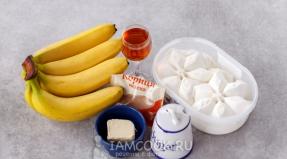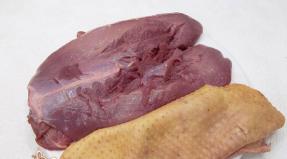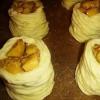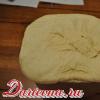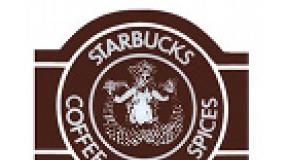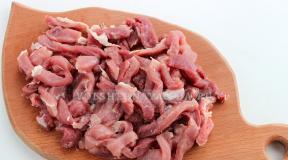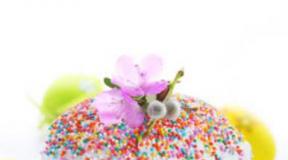Homemade chocolate melts at room temperature. All the secrets of tempering chocolate
Gather your equipment and preferably half a kilo - a kilo of chocolate. Finely chop the chocolate or use chocolate discs available from many manufacturers and sold in candy stores or online from professional chocolate vendors. The more chocolate you use, the easier it will be to manage the process.
- Try to cut the chocolate as evenly as possible. Chocolate that is cut evenly will also melt evenly and prevent overcooking. If you want, you can use a serrated knife to cut the chocolate into chunks, or you can look for chocolate chips that melt evenly.
- Set aside about 1/3 of the chopped chocolate for later use. It will not be used at the beginning of a double boil.
Fill one of your bowls with cold water. Fill it with enough water so that your second bowl of chocolate can sit comfortably in it without spilling water.
Place the chocolate in a dry stainless steel bowl. Melt it by placing it over a bowl of slowly simmering water. The bowl should be larger than the pot so that it does not fall into the water and is located at the edges of the pan.
- Do not bring the water under the chocolate to a boil. Also, do not turn on the gas on the stove more strongly. The more you try to melt the chocolate faster, the faster it will burn, spoil the taste and temper the process.
- Be careful not to get water into the chocolate or it will curdle. It is very important.
Heat the chocolate slowly until it reaches 43°-46°C. Once the chocolate has completely melted, it should be warm to the touch. Place the bowl of melted chocolate into a bowl of cold water and start stirring slowly but constantly. Once it begins to thicken and reaches a temperature of 35°-38°C, crystallization or "tempering" will begin and you can take the chocolate out of the water.
Add the remaining 1/3 of the untempered chocolate to the melted chocolate and stir. Mix the two forms of chocolate so that the final mixture becomes homogeneous.
Start the tempering or crystallization test at 32°C by dipping a spoon into the chocolate. It should become firm, strong and shiny in 2 - 3 minutes, at 18°-22°F ambient temperature. If it comes out blotchy or dull, you should continue to stir, applying heat and cold, to keep it soft and workable, but not too runny.
- It should be cool to the touch; a good temperature test is placing a piece on your bottom lip. If you feel the chocolate is cool, the temperature is most likely right.
Chocolate .... What a power it has that attracts so many people to itself. Magic, sorcery... It's incredible how chocolate "obeys", how waves flow from the bowl onto the marble surface. How he obediently gets out of the mold, and the products from it beat off every ray of light from themselves, play with a multitude of colors.
It is not so easy to tame it, you may need more than one attempt, and even when the tempering is successful, this does not mean that products made from it, whether they are candies, or simple chocolate bars, decor, or pouring sweets, will be ideal. glossy without streaks of cocoa butter on the surface, without a gray coating and sugar bloom.
The theme of chocolate is very voluminous. How your chocolate will look ultimately depends on many factors. Let's start in order.
Why temper chocolate?
Want to get the perfect chocolate product? Then you need to temper or pre-crystallize the chocolate.
Precrystallization endows chocolate with such qualities as hardness, beautiful satiny color, sonorous crunch when broken. As the chocolate cools, it shrinks, making it easier to remove from the mould. Poorly crystallized or non-crystallized chocolate becomes gray and dull.
When we melt chocolate, its crystal lattice is destroyed. We need to put it back together. To do this, you need to sharply lower the temperature of the chocolate, and then raise it again to the working temperature.
Selection of chocolate for work.
If a couple of years ago, it was safe to say that by buying a regular bar of chocolate in the nearest store and tempering it, you will get a good result, but now, having tried various brands, I can say that do not even start! Store-bought chocolate on a work surface exudes a liquid of "unknown origin". It can be tinted but not 100% glossy. Time will be wasted, and the result will not please you.
To familiarize yourself with the process, start with dark chocolate, with a cocoa butter percentage of at least 70 percent. I work for Callebaut 70.5% (70-30-38) Fluidity - three drops.
Choice of dishes.
It is very important to choose the “right” cookware for the job. Glass, ceramics or metal, heat up very quickly, retain heat for a long time. And we don't need this. We need a neutral material that would cool quickly and not get very hot. That is what plastic is.
Room temperature should not exceed 20 C. Otherwise, it will be very difficult to work with chocolate. in some cases it is not possible.
Accurate thermometer. Chocolate won't wait for you while you take its temperature. I’ll make a reservation right away that a needle thermometer is also suitable for work, but then there is a high probability of failure, and much more effort and energy will be spent on the whole process. Therefore ..... pyrometer to help you!
Temperatures:
- bitter chocolate: heating 50-55 C, cooling 27 C, working 31 - 32 C
- milk chocolate: heating 45-50 C, cooling to 27 C, working 30-31 C
- white chocolate: heating 40-45 C, cooling to 27 C, working 29-30 C
Types of tempering.
There are a large number of crystallization methods, and all of them work. You need to choose based on personal preferences and working conditions.
I will describe such methods as:
Tempering on a marble or granite slab
Tempering with a blender
Callet "seeding" method
In cold and hot water bath
"block" method
Tempering on a marble or granite slab.
These types of stone are chosen for tempering, since they need more time than others to heat up. It is possible to work on other surfaces, but only if you take a small amount of chocolate and work intermittently, allowing the surface to cool properly.
In fact, it doesn't matter how you cool the chocolate. Your goal is to lower its temperature as quickly as possible. The faster you do this, the better the result will be.
Marble surface, in my opinion, is the most interesting, fascinating and at the same time simple way of tempering. Of course, if there is one.
Difficulties in working with this method can arise if you take too little chocolate. It is best to start working from 300 g. Otherwise, a small amount will crystallize in seconds, in some places it will become hard.
The method itself is easy and reliable. When I work on the surface, I am always confident in a good result. Chocolate on it is well and evenly cooled. There are no areas where the chocolate has already solidified, while others are still warm (assuming clean work)
It is best for me to melt chocolate in a water bath, so the easiest way to control the process of increasing the temperature. I'm not afraid of moisture, because after boiling the water I turn off the fire, and the chocolate is heated only by hot steam.
Another advantage of the plate is that there are no residues of hardened chocolate at all. Nothing will freeze in the bowl. After work, I pour the melted chocolate from the container onto the work surface, and after hardening, I clean off the residue with a scraper.
Process:
1. Melt the chocolate to its maximum melting point. If this is a water bath, then after boiling the water, turn off the fire. Be careful! Not a single drop of water or excess moisture should get into the chocolate, otherwise it will "curl".
If you do it in the microwave, then heat at intervals of 10-15 seconds, mixing well each time.
2. When the chocolate has reached its maximum temperature, pour it onto the work surface (if the chocolate was melted in a water bath, do not forget to wipe the bottom of the bowl on which drops of water have accumulated)
3. Use a spatula to “drive” the chocolate over the surface until the chocolate has cooled to the desired minimum temperature.
4. Return the chocolate to the bowl, and very carefully raise it to operating temperature. Here you need to be extremely careful. An extra degree, and you have to start all over again.
5. Chocolate is ready to go. Be sure to pass the test, and do not start working until you see that the chocolate has crystallized. To do this, dip the end of the knife into the chocolate, and wait. If after 3 minutes at 20 C in the room it hardens and becomes matte - the crystallization was successful!
Chocolate sets very quickly in a bowl, so you need to work quickly. Keep a hair dryer near you, and if you see that it freezes, heat the surface for a few seconds and stir. Thus, the temperature of the chocolate can be increased by several degrees, and kept in working order.
2. Tempering with a blender.
This is not a complicated method and can quickly cool a small amount of chocolate. Most often it is used at confectionery competitions and festivals. Good if you need a minimal chocolate decor, do not stain all the dishes and surfaces with chocolate.
For this, 2/3 of the chocolate in callets, or any solid crushed state, must be placed in the blender bowl. Then gradually add chocolate heated to 50 C - exactly one third.
The blades of the blender rotate, hot chocolate melts the callets, which have a stable crystal lattice, and gives it to the whole mass.
If at the moment when all the chocolate has melted its working temperature, everything is ready. It's time to take a test!
3. Tempering by "sowing" method
This method is somewhat similar to the previous one. In it, too, callets with a stable crystal lattice are used for crystallization. Only here, the whole process is done by hand.
1. Melt 2/3 of the chocolate and add 1/3 of the callets to it. Interfere intensively. You will see how gradually the callets disperse in the chocolate. If at the moment when the mass has become homogeneous, the operating temperature has not been reached, mix in a little more cullets. Just a little! And stir furiously again! The operating temperature has been reached - do a test.
4. Tempering by "block method"
This method is the same as the previous one. Only callets are not poured into melted chocolate, but a whole block of chocolate (crystallized) is placed and they begin to stir. Its advantage over the previous one is that if the chocolate has reached the desired temperature, and the calllets have not dispersed, you will need to quickly "catch" them from the chocolate mass. Here, it will be enough to get a large block, and that's it. Test, and the chocolate is ready to go.
5. Tempering in a hot and cold water bath.
The name speaks for itself. We heat the chocolate in a hot bath, cool it in a cold bath, and warm it up again to a working one. Test and fight!
Storage of chocolate products:
Chocolate is sensitive to moisture, heat, unpleasant odors, light and air. It is best to store it in a sealed container.
The most common problems that arise during storage are:
1. Chocolate has an uneven granular coating of white color.
Sugar bloom can have several causes, but they all have to do with moisture. When the final product's chocolate capsule undergoes condensation, the sugar it contains dissolves and crystallizes, forming a white grainy texture on the surface of the capsule after the water is re-evaporated. Avoid contact of chocolate with moisture to keep your chocolates in perfect shape. Pack your chocolates carefully and store them in a refrigerator with low relative humidity and at a constant temperature. This will prevent condensation from forming on the chocolate capsules. If you are transporting chocolates from a colder place to a warmer place, allow them to acclimate for a few hours before unpacking them.
2. The chocolate is covered with a white film that disappears when touched.
Fat bloom is a natural phenomenon that can appear on any chocolate product in the form of a white-gray coating. But there are a number of factors that accelerate its emergence. Essentially, fat bloom does not affect the taste of the chocolate, but it does make it unappealing.
There are three reasons for the untimely appearance of this defect:
- Fat bloom occurs when the chocolate has not been tempered properly. After settling, the chocolate product will turn out to be unsolid, dull and without a resounding crackle, and fat bloom will appear in a couple of hours.
- Basically, fat bloom occurs when the fat in a fat-based filling (candy, marzipan, or other nut-based fillings) migrates into the chocolate capsule.
- Fat bloom appears faster if the storage conditions of the finished product are not met. Too high temperature or temperature fluctuations significantly accelerate the process of fat migration.
Let's move on to a very important topic. So important that your career as a chocolatier will depend on mastering these knowledge and, as a result, skills. The topic of tempering (or in the modern approach "PRECrystallization", which in no case should be confused with RECrystallization) has already been touched upon on the pages of this site dozens of times and will be mentioned more than once...
Precrystallization and tempering
Precrystallization is the process of preparing melted chocolate to form a solid. The concept of tempering, which was widespread in the past, was to achieve this goal by repeatedly bringing the chocolate to the right temperature. The desired result was not always obtained, even despite the strict observance of the temperature regime. This led to the conclusion that the correct temperature is not the only condition for the manufacture of a product of the required quality, although its values \u200b\u200bshould be in certain intervals. For optimal results, melted chocolate must be pre-crystallized.Due to the presence of cocoa butter, which, unlike other fats, has polymorphic properties, stable crystals, the so-called seed crystals, are formed. The creation of the required amount of seed crystals, which serve as the basis for further crystallization, and their uniform distribution in the chocolate mass is, from a physical point of view, a precrystallization process.
The goal of any of the precrystallization methods is to achieve a stable crystalline form of cocoa butter. Methods may be different, but this process always combines three essential elements: time, movement (mixing), temperature conditions. If melted chocolate is poured into a bowl and simply cooled, it will harden over time as its temperature drops, eventually becoming grainy and gray. And if you stir it regularly - a factor of movement - then the change in its state will occur much faster, the correct crystal structure will form, and the product will turn out to be much more attractive in appearance.
Successful precrystallization results in a product with the following properties:
- shine;
- hardness;
- fragility;
- aroma;
- homogeneous structure;
- long shelf life.
Incorrectly pre-crystallized chocolate has the following disadvantages:
- lack of gloss;
- grayish, whitish color;
- sensitivity to touch;
- granular structure;
- the rapid appearance of fatty deposits.
Precrystallization methods
There are several ways to precrystallize chocolate. Some are better, some are not as good as others. In each case, the result depends on the equipment and working conditions.1st way
The tempering method is classic but old-fashioned. This method is little used today, because it is too laborious and unhygienic.Pour about 2/3 of the melted chocolate onto the marble surface. Distribute the mass evenly and mix with a spatula until the chocolate reaches a temperature at which it begins to thicken a little. At this point, a large amount of seed crystals are formed, and therefore this part should be added to the remaining warm chocolate as soon as possible. This will raise the temperature a little, and the unstable crystals that have formed on the marble surface will melt again and transform into more stable crystalline forms.
In theory, the operating temperature for dark chocolate should not exceed 32-34.5°C. The operating temperature for milk chocolate should not exceed 30-32°C, and for white - 28-30°C due to the presence of low-melting milk fats in milk and white chocolate.
If not enough seed crystals form in 2/3 of the seed crystals, or if the remaining 1/3 portion is still too warm, all seed crystals are melted and the chocolate portion must be cooled again on the marble surface.
2nd way
This method requires a lot of time, but little effort. Melted chocolate is cooled (for example, in a freezer) until the mass begins to harden, which takes quite a long time. Thus, a large number of stable crystals are formed. Then, stirring constantly and vigorously, heat the chocolate to operating temperature. As a result of a slight increase in temperature, the excess of unstable crystals melts.3rd way
This method requires a thermal chamber or incubator with a very accurate thermostat. The chocolate melts in a very slow heating process.The pieces are preferably placed in a heat chamber or incubator the day before the start of work. The thermostat values must be set: for dark chocolate - 34-35°C, for milk chocolate - 32-33°C, for white - 31-32°C. If the chocolate is too thick the next morning, there are still too many seed crystals in it. In this case, the mass should be slightly heated, while stirring, until the desired state is reached. If the mass is more liquid than necessary, this means that the temperature was too high and the stable seed crystals melted, so the temperature should be set somewhat lower in the future.
4th way
The melted chocolate is cooled with constant stirring until the desired temperature is reached. This process takes some time. With this method, unstable crystals are not formed, since supercooling, which is the cause of their appearance, is excluded.5th way
The fastest and easiest way is grain (or "sowing"). Hard, previously tempered chocolate contains a large amount of stable crystals that can be used as seeds. This method is good because there is no danger of the formation of a large number of unstable crystals.Break the chocolate into small pieces or use chocolate tablets (callets). Heat the chocolate pieces to 40-45°C to melt them. When the required temperature is reached and the chocolate is melted, this means that all the stable crystals that were in the solid chocolate have melted. Then add 20-25% solid chocolate chunks, which will melt and serve as a source of stable seed crystals. The amount added depends on the temperature of the chocolate: the higher the temperature, the more chocolate should be added.
Using the microwave
The microwave oven can be a good helper for melting or pre-crystallizing a small amount of chocolate in a short time. It is indeed possible to quickly create a pre-crystallized solid chocolate mass. Melting chocolate in the microwave corresponds to the third method. It is very important to heat the chocolate for a limited period and stir regularly. When the chocolate begins to melt, it is necessary that a sufficient amount of stable crystals remain, otherwise the mass may become grainy. Do not heat chocolate (especially milk and white) at too high a power or for too long periods, there is a risk of burning.Chocolate is a terribly capricious matter, it is not easy to cook from it. He strives to spoil your grandiose plans: either he will turn gray, or he will exfoliate ... That will end
But there are people for whom chocolate behavior has long been no secret. When professional confectioners taught us how to work with chocolate, they unanimously said: it is not enough to be able to melt chocolate correctly. If you want your handmade sweets not to “turn gray”, that is, not to be covered with a white coating, to freeze well and quickly, not to melt on contact with your fingers, to be shiny and glossy, to crunch appetizingly on your teeth - you must definitely temper the chocolate!

Tempering chocolate is the process of heating/cooling it to certain temperatures, the purpose of which is to crystallize the cocoa butter in the chocolate. Tempering is necessary so that chocolate products (chocolate decorations, chocolates, chocolate coatings) are shiny, crispy, hard and easy to remove from molds filled with chocolate.
Remember the 3 stages of working with chocolate:
1. Chocolate is heated to:
black bitter chocolate - no more than 45C(some sources indicate 50C, we ourselves heat up to 45 in master classes)
milk chocolate - no more than 43C
white chocolate - no more than 40C
Constantly stir so that the mass warms up evenly.
2. After the limit temperature is reached, remove the bowl with chocolate from the bath and begin to stir vigorously so that the mass cools quickly enough to:
dark chocolate - 27C
milk chocolate - 25C
white chocolate - 25C
 To speed up the process, add 20% cold cullets to the melted ones if you are melting chocolate drops or 20% grated or finely chopped cocoa butter if you are brewing "zero" chocolate from cocoa beans and cocoa butter. This 20% should be set aside in advance before filling the bowl with chocolate to melt.
To speed up the process, add 20% cold cullets to the melted ones if you are melting chocolate drops or 20% grated or finely chopped cocoa butter if you are brewing "zero" chocolate from cocoa beans and cocoa butter. This 20% should be set aside in advance before filling the bowl with chocolate to melt.
3. The final stage - we heat up quite a bit of chocolate again to start shaping or casting it.
dark chocolate - 32C
milk chocolate - 30C
white chocolate - 28C
Those. we heat the chocolate (melt), then cool, then heat a little more. In scientific terms, the result of crystallization or tempering is the formation of stable Beta crystals. It is these stable crystals that make chocolate hard, shiny, crunchy, and shrinkable. It is thanks to the latter that, having shrunk, the chocolate easily leaves its mold.
Crystallization seems to be a mysterious process, because we cannot see with our own eyes what is happening inside the chocolate. This process is controlled only by temperature, by sight, and by touch.
Attention: only high-quality chocolate is suitable for tempering! Do not try to temper all sorts of Alenka tiles and other things that contain little chocolate
So, details.
Step one. In order to melt chocolate, you will need a "water bath": a bowl in a bowl. Fill one of your bowls with cold water so that your other bowl of chocolate can sit comfortably in it without spilling the water. Place the chocolate in a dry stainless steel bowl. Bring the water in the lower pot to a boil and reduce the gas to a minimum. Place the bowl of chocolate over the bowl of hot water so that the bottom does not touch the water and the steam does not get into the chocolate.
Do not turn on the gas on the stove harder. The more you try to melt the chocolate faster, the faster it will burn, spoil the taste and temper the process. Be careful not to get water into the chocolate or it will curdle. Make sure your bowls, work surfaces and spatulas are completely dry. It is very important!

At the first stage, we need to melt the chocolate: bring it to a liquid state, separate all the molecules in it from one another and melt them. That is, it is important to ensure that the temperature of the melted chocolate is not lower than 45, but does not exceed this norm. Then everything will turn out right.
Particular attention is the temperature. If, for example, chocolate is melted to a temperature of 40C, it is quite possible that it will be liquid, but the molecules at this temperature will still not be able to separate well from each other and completely melt. As a result, sad white stains can be observed on the finished chocolate products.
Otherwise, if the chocolate is overheated, it will become grainy.

Step two. Chocolate needs to be cooled quickly enough to a temperature of 26-27C. We can do it this way: add 20% cold cullets to the melted ones if you are melting chocolate drops or 20% grated or finely chopped cocoa butter if you are brewing "zero" chocolate from cocoa beans and cocoa butter. This 20% should be set aside in advance before filling the bowl with chocolate to melt.
The third step is to heat the chocolate a little again in a water bath. If the thermometer shows 31.5-32C and the temperature does not rise further, this is what we need. Make a test: take a teaspoon of chocolate, pour it on parchment or foil, leave it at a temperature of 15 to 22C. In a few minutes, the test should show that the chocolate sets, hardens and breaks.
If so, you can safely start working. If the temperature on the thermometer at the last stage exceeded 33 ° C, the test chocolate remains liquid and sticky, does not show signs of solidification - the chocolate molecules have destabilized and the tempering process must be restarted. This time, you can heat the chocolate up to 45 C in the first step. You can temper the same chocolate almost indefinitely.
You can be calm for sweets and chocolate decor made of tempered chocolate - it will remain shiny and crunchy at temperatures up to 23-24C.
How to store chocolate and why.
. How to melt chocolate properly.
. Why and how to temper chocolate?
. What are the ideal temperatures for rooms, molds and fillings?
. How to chill chocolate.
. How to store finished products.
How to store chocolate
Chocolate is sensitive to moisture, odors, and when exposed to air and light, it oxidizes. Chocolate must be protected from light and air and must be stored in a cool, dry place, at a stable temperature between 12 and 20°C. Always remember that the packaging in which chocolate is stored must be closed.
How to dissolve chocolate.
Chocolate should be melted at 40 to 45°C. Chocolate must not be exposed to direct heat sources. Chocolate is best melted in a finely controlled oven or bain-marie to heat evenly to between 40 and 45°C. This is the ideal temperature to start the tempering process.
How to temper chocolate. Why is tempering needed?
The purpose of tempering chocolate is to crystallize the cocoa butter in the chocolate, which is related to the working temperature of the chocolate. During the tempering process, the cocoa butter in chocolate changes into a stable form. This gives the chocolate its hardness, brittleness, and luster after cooling. If chocolate is melted at 40 to 45°C and then cooled, the finished product will not be glossy and hard.
Tempering on a marble slab





On a marble surface
1. Melt the chocolate between 40 and 45°C in the microwave (preferred) or in a water bath.
2. Pour 2/3 of the mass onto a cold marble surface.
3. Knead the chocolate with a spatula and scraper.
4. Continue kneading until the chocolate thickens (temperature +27C): crystallization has begun. You will see 'icicles' dripping from the spatula(*).
5. Pour the crystallized chocolate into the bowl with the remaining 1/3 of the chocolate and mix well.
6. Chocolate is ready to go. If the chocolate thickens, warm it up slightly to operating temperature. Always check: dip the tip of a knife or a piece of parchment into the chocolate, if the chocolate is properly tempered, it will harden in 3 minutes at about 20°C.
(*) If all the chocolate is poured onto the stove, it must be kneaded until the temperature drops 1-2 degrees below the working temperature.
Crystallization with Kallet
Crystallization can be done very simply by adding previously crystallized chocolate to melted chocolate. To do this, you can use chocolate in the form of callets. Callets have previously been tempered and contain cocoa butter in crystalline form. The required number of callets depends on the temperature of the melted chocolate and callets. When melted chocolate is around 40°C, you need to add 15-20% of cullets that are 15-20°C.




1. Melt the chocolate at 40-45°C in a gastronorm container equipped with a thermostat or microwave oven.
2. Set the oven temperature to 32°C for dark chocolate or 30°C for white and milk chocolate and immediately add 15 to 20% of the cullets at 20°C.
3. Stir the chocolate well until the Callets are dissolved. If the Callets dissolve too quickly, the chocolate was too warm. Add more Kallet and continue mixing.
4. With this method, you will quickly get your chocolate ready to go.
Tempering in a wheel type machine




1 and 2. Melt the chocolate in the tempering machine (set the thermostat to 45°C) then lower the temperature (+/- 32°C for dark chocolate, +/- 30°C for white and milk chocolate) and immediately add 15-20% Kallet room temperature (20°C).
3. The machine will mix the Cullettes with melted chocolate, spreading butter crystals throughout the volume. If the Callets dissolve too quickly, the chocolate was too hot. Add more Kallet and continue mixing.
4. After Kallet has completely dissolved and the working temperature has been reached, the chocolate is ready for use. To use this method in other types of tempering machines, we recommend that you consult your equipment supplier.
Tempering in the microwave






The method is well suited for tempering chocolate in callets.
1. Place some Callet in a plastic bowl.
2. Set the maximum microwave power to 800-1000W. Put the bowl in the microwave and start to "dissolve" the callets.
3. Remove the bowl every 10-15 seconds and stir the callets. Do not allow overheating above 34C for dark and 30-31 for milk and white chocolate! Use accurate thermometers (pyrometers).
And finally, a few tricks:
1. How to check crystallization.
To check the result of tempering, put some chocolate on the tip of a knife or a strip of parchment. If the chocolate is well tempered, it will harden within 3 minutes at an air temperature of 18-20°C and will have a good sheen. If this does not happen, continue tempering.
2. What should I do if the chocolate is too thick?
After a certain time, the chocolate may begin to thicken quickly. This is called over-crystallization and is caused by a sudden, rapid increase in cocoa butter crystals. Super-crystallized chocolate will be less shiny and less brittle as it cools. It is also very difficult to remove air bubbles from it during operation. How can this be fixed?
It's simple: raise the temperature by adding hotter chocolate and stirring well, or heat the chocolate in the microwave. Heat the chocolate carefully so as not to destroy the butter crystals at too high a temperature. Remember to constantly stir the chocolate.
What is the ideal temperature for a mold and filling room?
Ideal room temperature ± 20°C
. Fillings: The temperature of the filling should be very close to the temperature of the chocolate (where possible). If the difference between the temperature of the filling and the temperature of the chocolate is too great, this will cause disturbances in the crystallization of the cocoa butter and the final product will be opaque and unstable to temperature. The best result is achieved when the temperature of the filling is about 5°C lower than the temperature of the chocolate.
. The temperature of the molds should be as close as possible to the air temperature in the shop (+20°C). A slight heating of the forms is recommended (for example, with a hairdryer). Make sure that the temperature of the mold does not exceed the operating temperature of the tempered chocolate. These precautions will help you get great results.
. Important note: The chocolate may continue to cool while you work. This is caused by the rapid increase in the amount of cocoa butter crystals. The solution to the problem may be to add a small amount of warmed chocolate or increase the temperature.
How to cool chocolate
The ideal temperature for cooling chocolate when working with molds is between 10 and 12°C. Coating chocolate sets best between 15 and 18°C. Temperature changes of more than 10°C must be avoided at all costs. Please also note that there must be a large amount of cold air around during the cooling of the molds, as a large amount of heat must be removed during the chocolate curing process. Chocolate coatings should preferably be refrigerated without ventilation. When the molds are ready to be cooled, they can be placed in a colder place than the shop. The molds can then be placed in the refrigerator.
How to store prepared chocolate
Like raw chocolate, finished products are sensitive to temperature, unpleasant aromas and tastes, light and air, humidity and storage time. Here are typical problems that can occur during storage:
Fat bloom
This problem is caused by a thin layer of fat crystals on the surface of the chocolate. The chocolate loses its luster and a soft white layer appears on the surface. This layer makes chocolate unpleasant to look at. The cause of fat bloom is the recrystallization of the oil and/or the movement of filling fats into the chocolate layer. Storage at a constant temperature prevents the appearance of fat bloom.
sugar bloom
Compared to fat bloom, sugar bloom consists of a rough and irregular layer on the surface of the chocolate. Sugar bloom is caused by condensation, such as when chocolate is taken out of the refrigerator and moisture condenses on its surface. The condensate dissolves the sugar in the chocolate. Then, when the water evaporates, the sugar remains on the surface of the chocolate in the form of large, irregular crystals. This gives the chocolate an unpleasant appearance. Sugar bloom can be prevented by avoiding sudden changes in temperature when moving the chocolate from a cold to a warmer place (thus preventing condensation). Chocolate products brought from a cold place should be kept in a warmer room for some time before opening the package. Thus, condensation can be avoided. It is vital for chocolate to be stored under ideal conditions for as long as possible without getting defects or decay.
The following factors must also be considered:
Storage time
The following rule applies to chocolate products: a short storage time guarantees the best quality. Normal storage time for chocolate:
- white chocolate: 12 months
- milk chocolate: 18 months
- dark chocolate: 24 months
In the warehouse, it is recommended to implement a stock control system based on the FIFO (first in/first out) principle. With this system, products that have been in storage the longest are shipped first. In this way, no product remains in storage for too long and optimum freshness is guaranteed.
Temperature
The ideal storage temperature for chocolate is between 12 and 20°C. At higher temperatures, the chocolate softens and becomes matte. Lower storage temperatures are less dangerous. When moving to warmer rooms, sugar bloom (condensation) should be avoided. Sudden changes in temperature are also not recommended because they can cause fat bloom.
Storage
Chocolate is very susceptible to the absorption of different flavors. That is why chocolate should be stored in a place that does not have harsh or unusual odors. Good warehouse ventilation is essential. Chocolate should never be stored near strong smelling foods (eg cheese, fish, meat, lemons, etc.). Chocolate packaging must be neutral, which means that it must not give off any odour. It goes without saying that smoking areas should not be placed close to chocolate products.
Air and light
Air and light can break down the fats in chocolate. This leads to a significant change in taste and the appearance of an unpleasant odor. This is caused by oxidation. Therefore, it is very important to protect the chocolate as much as possible from air and light (including artificial light). Chocolate should also be stored in sealed containers. Dark chocolate and milk chocolate naturally contain many antioxidants (substances that delay the oxidation process), but white chocolate does not contain these substances and is more sensitive to oxidation. White chocolate needs more protection.
Humidity
Chocolate must be protected from moisture. As a general principle, the maximum relative humidity in a warehouse should not exceed 70%. Storing chocolate products on the floor or near walls should be strictly prohibited because it increases the risk of absorbing moisture.
Possible problems
| Problem | Cause | Solution |
| Difficulty getting out of shape | Poorly tempered chocolate Mold cooling temperature is high The chocolate layer is too thin |
See "tempering" See "cooling" Use less fluid chocolate |
| White or gray coating on chocolate | Cooling is too slow "Super-crystallized" chocolate |
See "cooling" See "tempering" See "tempering" |
| Cracks in molded chocolate | The fridge is too cold The layer is too thin and cooled quickly |
See "cooling" |
| Matte surface on molded chocolate | "Super-crystallized" chocolate The fridge is too cold Shape is too cold Shape is not clean |
See "chocolate temperature" See "refrigerator temperature" See mold temperature See "clearing forms" |
| Mass thickening during operation | Excessive crystallization of chocolate | Add temperature Add a little warmer chocolate. Do not add cocoa butter. |
| The surface is not shiny | Filling is too cold It is very cold in the workshop or in the refrigerator Chocolate at the wrong temperature |
See mold temperature See "room temperature" See "tempering" |
| Fingerprints on chocolate | Product touched by wet or hot fingers | Do not touch the surface with wet or warm fingers. Use gloves if necessary |
| Dirty forms | Fingerprints inside the mold Forms are soiled in the filling Dirt in shape Poorly tempered chocolate cold forms |
How to clean molds: With warm water and a very mild detergent. Use a very soft cloth. Sponges or brushes may scratch the molds. Wash with warm water and wipe off the water from the inside. See "tempering" See mold temperature |
* article based on "Useful information" (c) Barry Callebaut
